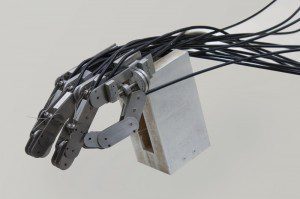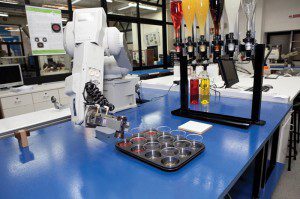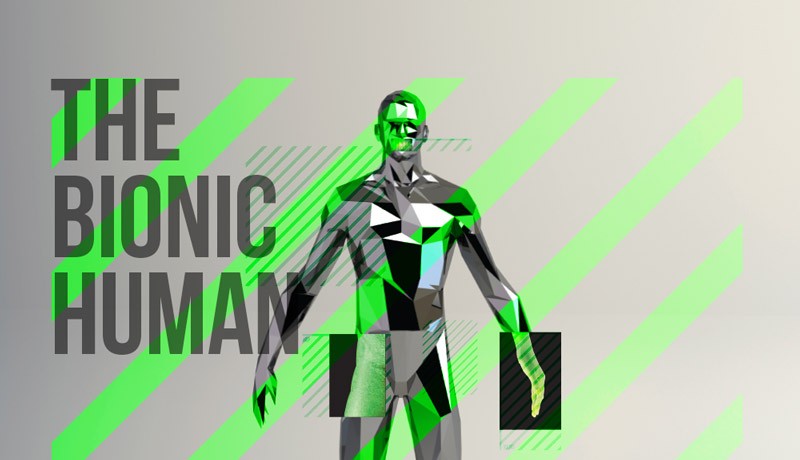Faster, fitter, and flawless? What would it take to build a Bionic Human? Ing. Emmanuel Francalanza delved into research at the Faculty of Engineering to see how Malta could contribute. 3D Art by Jean Claude Vancell
From the ‘Bionic Woman’ and ‘Cyborgs’ to the ‘Six Million Dollar Man’ and ‘Robocop’, science fiction has fired our imagination of augmenting humans with man made prosthetics. An upgraded human would prevent, even correct, the errors of evolution. Although a wonderful machine, its complexity makes it fragile and easily harmed.
Our bodies also suffer from disease. As the population ages and obesity rates increase, a swell in the need for hip and knee replacements is inevitable. This is when medicine turns towards engineering. Biomedical engineering combines engineering with medicine to build the bionic human.
Upgraded Teeth
First of all to construct the Bionic Human we need the right materials. The human body naturally attacks implanted foreign materials. Transplanting organs needs heavy drug use to knock-out the immune system and prevent the immune system attacking the organ. These drugs lead to many complications but are our current best tool. A cleverer approach would be to deceive the human body into accepting these foreign elements system.
Biocompatible materials can trick the body into thinking they are one. Biomaterials can be used for simple dental material to complex bone replacements. These materials have two main characteristics, their bulk material properties and surface composition. The bulk material properties take care of toughness, rigidity, integrity, while surface composition defines how the implant interacts with other materials and the surrounding tissue.
Memories of toothache: sleepless nights, stress, and waiting in a dentist’s chair for a dreaded tooth filling. These memories can become a footnote in history. Materials scientist Prof. Josette Camilleri and materials engineer Dr Bertram Mallia (University of Malta) are collaborating to develop a material that can replace current dental sealer to reduce the number of visits at the dentist, make them more pleasant, and help healing after surgery. This material is composed of the same compounds that hold our houses together, Portland cement. The cement reacts to other naturally occurring minerals in our bones to trick the body into believing that the material is normal bone. It is then prepared into a resin-based mixture which sets when exposed to a dental light. These scientists are experimenting with different compositions to try and find the best mixtures to reduce surgery time while optimising bio-compatibility and strength, to ensure your teeth won’t break when eating a tough bread crust!
Replacement limbs
Worldwide about 10% of men and 18% of women suffer from arthritis. Many will need hip and knee replacements which last on average 10 to 15 years. They deteriorate due to high stresses imposed by the human body, and wear and tear; we are constantly using these dynamic joints. Metal materials are commonly used since they complement good mechanical properties with reasonable costs.
Yet even metal cannot take the stress our legs regularly take. Leg implants frequently fail. The implants loosen, dislocate, or wear down. Survival rates are extremely unsatisfactory and there are better materials like ceramic-on-ceramic implants, but these are much more expensive. Dr J. Buhagiar and a team of engineers and medical researchers are developing new surface treatments for metal-on-metal implants to make them last longer. The main problem is that the two metal surfaces between the moving joint parts wear each other down.
“Worldwide about 10% of men and 18% of women suffer from arthritis. Many will need hip and knee replacements which last on average 10 to 15 years”
To improve wear resistance they are infusing the metal (cobalt-chromium-molybdenum alloy) with carbon using a patented method called Kolsterising®. The researchers infuse the metal with different amounts of carbon. Each material is then tested to check its properties. Material surfaces are analyzed with high-end microscopes to see the surface nano-structure, biocompatibility is tested to see if the body accepts it. A host of other experiments figure out wear resistance. Ultimately, this will find which material has the best improvements.
Better hip implants will help humans live longer and more comfortably. By extending implant life expectancy the need for revision surgery is reduced. This leads to two main benefits: avoiding the pain and hassle of redoing a total hip replacement, and reducing the financial burden on national health institutions.
Repairing the bionic human
If we are to try to replicate human body parts to make a bionic human, we have to first understand how the human body works. The human skeleton bears the body’s weight, while muscles, ligaments, and joints allow us to walk, talk, and play football. Understanding these systems from a mechanical engineering perspective is called biomechanics.
There are two ways we could study the human body: use human guinea pigs to test every engineering dream, or create a computer model of a human. For obvious ethical issues scientists prefer computer models. Engineers can use the same know how and techniques used to model bridges when analysing the human body.
In one of their studies mechanical engineer Dr Ing. Zdenka Sant and her research team simulated the human breastbone and sternum. This computer model is very useful for heart surgeons, a mechanical simulation model of the sternum allows them to plan the best path to access the heart and nearby vessels. Planning the best route to the problematic area reduces a patient’s complications and reduces the risk of things going wrong. By only passing through the minimal tissue patients recover more quickly.
Our bodies are so well designed that each organ efficiently occupies the least space possible. Sounds great but constitutes a problem for implanted devices, where can they fit? Enter biomedical devices. These implants sustain or replicate bodily functions, take pace makers and artificial heart valves. Miniaturisation needs micro and nano manufactured parts. Parts so small that they are impossible to view with the naked eye. This brings many challenges and requires precise manufacturing techniques. Dr Ing. Philip Farrugia together with a team of manufacturing engineers and researchers are currently developing technologies capable of mass-producing such micro components. The EX-MMIM project a number of Maltese manufacturing companies to develop microinjection molding processes. This type of research partnership ensures that knowledge generated in the research labs is efficiently transferred to industry.
Other types of biomedical devices help doctors during complex operations on the human body. Minimally invasive surgery uses a small incision to the body and the surgeon directs surgical tools to operate through these cuts. Prof. Ing. Jonathan Borg lead a research team that developed a new tool used for minimally invasive surgery. Laparoscopic surgery, a specialized form of minimally invasive surgery, uses tools that have to pass through small incisions the size of a one-cent coin. The problem is that each part of an operation needs a tool to do a different job from grasping to cutting. By studying operating procedures and how surgeons use these tools the research team developed a tool that combined different functions. The tools did not need changing during the operation, minimising the operating time which keeps the surgeon relaxed and the patient healthier. The minimal impact these tiny tools leave means the patient usually spends days in hospital instead of weeks.
A hand please

And what if our Bionic Human needed an artificial hand? Then we would need to design and construct a robotic hand with a controller able to reproduce the intricate movements of the human hand. Over the last fifteen years, Prof. Ing. Michael A. Saliba has been developing robotic hands that can grasp, and manipulate fine objects. His team have also developed gloves to control robotic hands remotely. Replicating the dexterity of the human hand is no mean feat! The human hand can execute 21 different joint motions (not including wrist and arm motions). Their combination lets us pick delicate crystal glasses or climb sheer cliff faces. Research on the measurement of dexterity in human hands has led to artificial hands design guidelines that achieve a fair balance between dexterity and simplicity. Nine carefully selected and designed joint motions would be all we need for our Bionic Human.
Apart from finger movement, robots also need to control the force with which they grasp objects. No one likes bone-crushing handshakes. The force needs to be carefully monitored and adjusted. Imagine you want to pick up a fragile test tube with your robotic hand. Pressing too much would shatter it to pieces, not pressing enough would drop it to the floor. Local roboticists have developed sensors that can sense an object slip from a robotic hand before it starts to fall. Prevention is better than cure.
Your personal assistant
Our Bionic Human might need an assistant on their quest. But not just any robot, an intelligent robot like Marvin from Hitchhikers Guide to the Galaxy (the cleverest robot ever built). Cleverness needs the design and implementation of intelligent controllers. And what better way is there to think cleverly like us, but to replicate our brains? Neural networks do such a job. These software programs are configured to learn from specific behaviors and associate a particular output to a triggered input. When we slip or lose balance (input) our body intelligently reconfigures our muscles (output) to avoid us falling on our backsides. This approach allows a robot to continuously adapt itself on its own to changes it observes around it. By doing so, the robot can move around on its own reliably. In Malta, Prof. Ing Simon Fabri and his team at the Control Systems Engineering Laboratory are helping build the future’s intelligent robots. They are designing control systems to allow robots to move around and behave with little human help.
Science Fiction becoming reality

In Star Wars, the force is used to move objects just by using thought. Jedi Knights need years of training to harness this force. The ability to move objects just by thought is possible, not through a mystical force but through a computer.
Our Bionic Human will be able to communicate with and control machines with the power of his or her brain. Today we have already taken the first steps to make this Sci Fi dream a reality. Electrodes can be attached to a person’s scalp to read the electrical signals from a person’s brain. These brain signals are called Electroencephalographic (EEG) recordings and since they need to pass from our brain to the surface of the skin, the readings become noisy and fuzzy. To extract useful information the signals are fed into a sophisticated computer program (signal processing techniques) to tease apart the confusion. The computer can then interpret our thoughts into commands. For example, ‘I want to move my arm left’, and a robotic arm or wheelchair moves, the same command could even be used to switch on a TV if eye tracking software detecting ‘I’m looking at my flat-screen monitor’.
This is the world of brain to computer interface devices. These devices open up the possibility to patients suffering from reduced muscular control to obtain a degree of interaction with the physical world. Applied to everyday circumstances they could help us drive a car by thinking about it, or more importantly avoid a car crash when your brain registers an accident ahead before our muscles have time to respond. Not only can they give mobility to everyone, but also save lives.
Locally, Prof. Ing Kenneth Camilleri and his team have been experimenting with the use of brain signals to communicate with the environment. Their work has helped tease apart these signals to help computers understand them better and faster. A major limitation in current technology is the time and computer power you need to decipher these signals. Their computer algorithms are aiming for brain signals to be read and interpreted as they form.
“Does this all mean that on our next call to the police we should expect Robocop to come to the rescue?”
Does this all mean that on our next call to the police we should expect Robocop to come to the rescue? And, this Robocop will be shooting and arresting criminals with his augmented body, while controlling robotic helpers through his thoughts. Well definitely not. Whilst there have been large advances in engineering in the past 50 years, we are still a long way from the dreams of science fiction authors and movie directors.
But some of this technology is already finding its way into our daily lives. The next time you visit the dentist, keep in mind the engineers who have worked relentlessly to make your experience less terrifying and perhaps the next video game console may work just by thinking about it.







Comments are closed for this article!